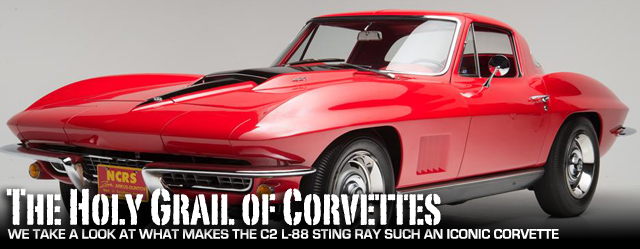 [1]As with so many compelling stories involving the evolution of the Corvette [2], the tale of the legendary 1967 L88 begins with Chevrolet’s iconoclastic visionary, Zora Arkus-Duntov. Among his many innovative and important contributions, Duntov was the first to encourage Chevrolet to install a manual transmission and larger engine into the Corvette, converting the 1956 version into a genuine sports car. It’s hard to imagine today, that despite the Corvette’s initial worldwide impact as a magnificent show car, the first production models were dissed as being more poseur than performer, and the rudely nicknamed “plastic bathtub” was very nearly axed from the Chevrolet lineup early on. From the beginning though, Duntov recognized and helped to orchestrate the Corvette’s true fate, as he was constantly at the helm leading the charge into the proper development path.
[1]As with so many compelling stories involving the evolution of the Corvette [2], the tale of the legendary 1967 L88 begins with Chevrolet’s iconoclastic visionary, Zora Arkus-Duntov. Among his many innovative and important contributions, Duntov was the first to encourage Chevrolet to install a manual transmission and larger engine into the Corvette, converting the 1956 version into a genuine sports car. It’s hard to imagine today, that despite the Corvette’s initial worldwide impact as a magnificent show car, the first production models were dissed as being more poseur than performer, and the rudely nicknamed “plastic bathtub” was very nearly axed from the Chevrolet lineup early on. From the beginning though, Duntov recognized and helped to orchestrate the Corvette’s true fate, as he was constantly at the helm leading the charge into the proper development path.
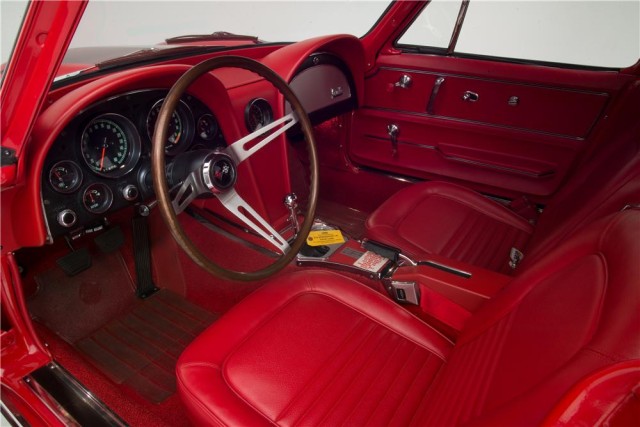 [3]
[3]Recently-retired National Corvette Restorers Society judging chairman Roy Sinor stated that the $3.85 million L88’s interior was perfect. Barrett-Jackson [4]
In 1965, led by Duntov, Chevy’s Corvette engineering group began developing a thinly veiled, flat-out race version of the Chevrolet Mark IV big-block. They referred to it as the RPO L88 option package. Two years later all of the hardware for this ultra high performance engine was sorted out and ready to race. On April 1, 1967 at the 16th annual running of the renowned 12 Hours of Sebring, Corvette’s L88 option package made its debut with the Sunray DX Motorsports team.
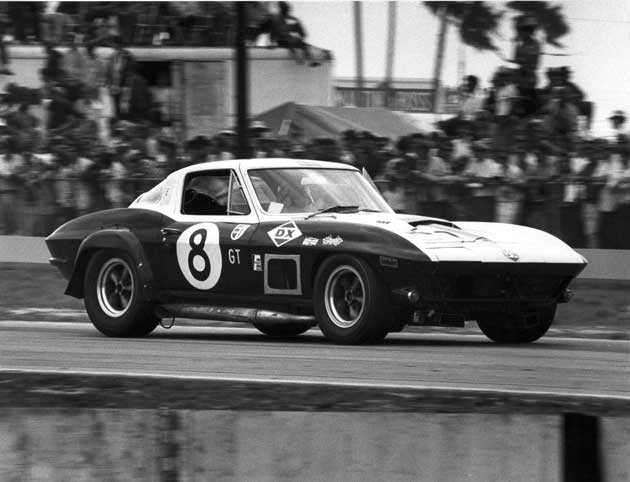 [5]
[5]Sunray DX drivers Dave Morgan and Don Yenko raced the L88 to victory at the 1967 12 Hours of Sebring. Corvette Action Center [6]
Long before the Sunray team could make out their Corvette’s characteristic quad headlamps piercing the night, they could clearly hear it exiting the final ninety-degree turn at the end of Sebring’s long back straightaway, the thunderous roar of the 600 horsepower big block rang a note unlike anything else on the track that day. When the checkered flag fell at 10:00 pm, Sunray’s drivers Dave Morgan and Don Yenko and their L88 Corvette had bested some of the world’s finest purpose built and production based racers to finish first in the coveted GT class and 10th overall.
The RPO L88 option package created the baddest most radical Corvette of them all, and shortly after the red, white, and blue Sunray DX racer took its class victory at Sebring, it was made available as a factory road car straight from the St. Louis, Missouri assembly line. And therein lies the rub. The car, after all, had been clocked at Le Mans at 171 mph, but In order to make the car eligible for SCCA [7] A-Production and FIA GT events, the L88 had to be a standard factory option, so GM [8] quietly offered it to the public.
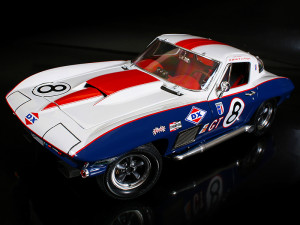 [9]
[9]The famous L88 option made its debut in this red, white, and blue Sunray DX Motorsports Corvette. eBay [10]
Being that the L88 was, for all intents and purposes, a production racecar, and in part because of GM’s on again, off again relationship with racing, Chevrolet actively discouraged L88 orders from dealerships and the public. The L88 was first offered to teams such as Sunray DX Motorsports to be contested in events such as Sebring, Le Mans and Daytona, but it was never intended as a boulevard cruiser.
L88s were produced from 1967 to 1969 and during the transition from the C2 Sting Ray to the C3 body style. As a limited series of around 200 cars, the L88 was sold as both coupes and convertibles. The rarest of these are the original twenty 1967 C2 L88 Corvettes. Packed with factory competition hardware, the L88 package was an ordering option that simply transformed the Corvette into a pure race car. As a result of the increasing and more stringent emissions standards, the L88 was forced to be canceled in 1969.
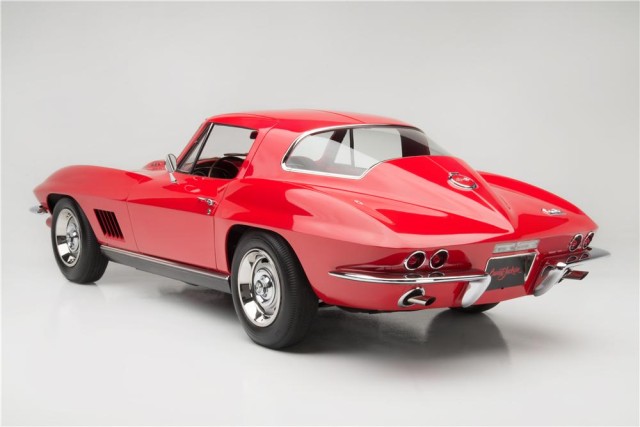 [11]
[11]The exclusive red-on-red Chevrolet Corvette is considered to be the best 1967 L88 in the country as judged by National Corvette Restorers Society. Barrett-Jackson [4]
At the heart of the L88 option package was a monster 427 cubic inch big-block engine, similar only in block casting to the engine first offered in 1966. After two years of development, almost every other component was reconsidered for power and racing endurance. The engines were all built at the Tonawanda, New York plant and featured the Can Am-spec aluminum heads with 2.19-inch intake and 1.84-inch exhaust valves.
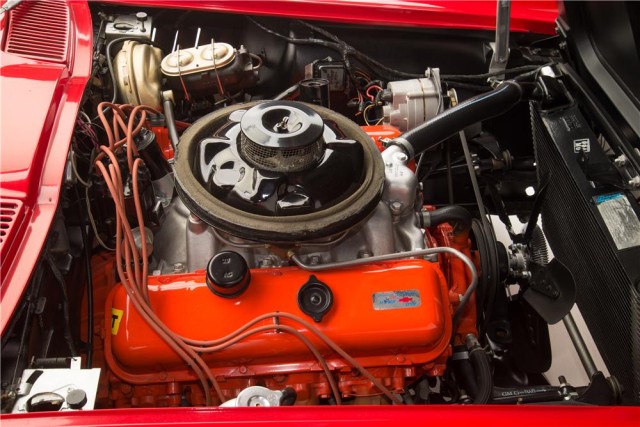 [12]
[12]The L88’s reported output of 430 horsepower was greatly understated. Barrett-Jackson [4]
The L88’s reported output of 430 horsepower was measured at 4,600 rpm, and at best, that was greatly understating the actual output. That particular power reading was measured with cast iron exhaust manifolds and mufflers in place, but the L88 hungered after an unrestricted exhaust path. Running through an open exhaust, on 103 octane racing fuel (the fuel warning sticker, an important detail, is still attached to the center console); the L88 would realize its true potential – nearly 600 hp at 6,500 rpm.
While the regular L71 engine and L88 shared the same displacement, the L88’s cost twice as much, and took the big-block theme a few steps further. The RPO L88 option package also incorporated a forged and Tuftrided steel crank, forged rods, 12.5:1 pistons, aluminum heads, a radically new solid lifter cam, cold air induction, and a single Holley 850 CFM dual feed carburetor perched atop an aluminum intake manifold. With any racing car platform, the L88 left out the fan shroud, choke and often, the heating system.
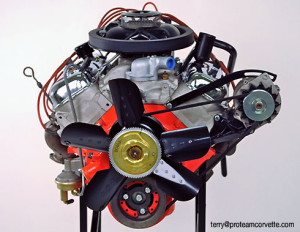 [13]
[13]The RPO L88 is one of the rarest motors in the world, 427-560 hp. ProTeam Corvette [14]
The L88 option package included much more than just an engine upgrade though.
Chevy made several individual options mandatory, including the G81 Positraction differential, the transistorized ignition, as well as RPO C48, which deleted the normal radio and air conditioning and heater/defroster system to cut down on weight and to further discourage the car’s use on the street.
Other required factory upgrades included a Muncie M22 Rock Crusher 4-speed or M20 Hydramatic Transmission, power-assisted heavy duty brakes, an F41 heavy duty suspension with new coil springs and dampers and a special cowl induction hood. After all was said and done, the L88 package doubled the price of a standard Corvette.
Had you been fortunate enough to purchase one of the original twenty C2 L88s for the estimated ten-grand sticker price, you would be considered a brilliant investor today. At the 2013 Frankfurt Motor Show, where hybrid supercars and lofty vehicles with butterfly doors were vying for attention, a classic Corvette was setting an auction record in Texas at the same time. The third-annual Mecum auction in Dallas featured more than 1,400 cars, but the 1967 convertible Corvette L88 was the undisputed star during the four-day event. With a final hammer price of $3.2 million ($3.52 million with fees), it became the most expensive Corvette ever sold at auction.
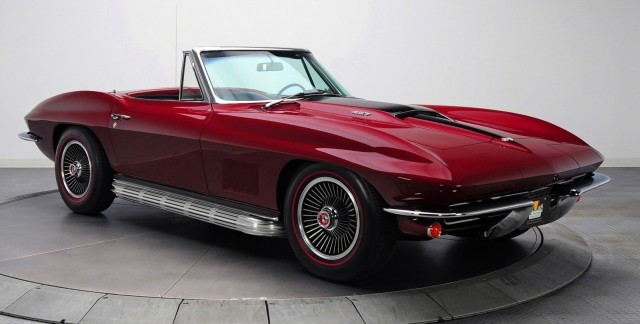 [15]
[15]The convertible L88 sold at the third-annual Mecum auction held the record as the most expensive Corvette for only four months. NoCarNoFun [16]
The car, painted in Marlboro Maroon, belonged to renowned collector, Buddy Herin, and it was one of the twenty examples built in 1967. It carried with it a formative race pedigree, having won the 1967 NHRA A/Sports Nationals at Indianapolis. There were plenty of photos and time slips documenting its racing history too, including its maiden run at Puyallup Dragway in Puyallup, Washington.
The record setting Corvette was originally sold to Jim Elmer by Lyman Slack Chevrolet of Portland, Oregon. The aluminum-headed 427-powered L88 was immediately modified for drag racing with the simple addition of headers and seven-inch drag slicks, according to Mecum’s description. These simple modifications allowed the car to deliver a quarter-mile run of 11.47 seconds, which Elmer pared down to 11.12 seconds at 127.45 mph at the 1967 Indy Nationals.
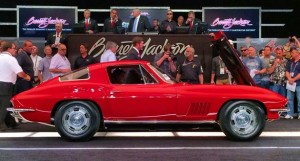 [17]
[17]Bidding for the L88 coupe took less than two minutes to break the standing record by almost ten-percent. Barrett-Jackson [4]
It’s anyone’s guess how high the ultimate bid for one of remaining twenty will reach in the near future. The last record for a Corvette sold at auction stood for five years, before Herin’s car set the new record last year. Only four months later during Barrett-Jackson’s celebrated eight-day auction extravaganza, a red-on-red (a combination that is thought to exist only on this car) 1967 L88 coupe was hammered down at a staggering $3.5 million ($3.85 million including an additional 10-percent in fees). The exceptional second-generation C2 Corvette was considered to be the finest 1967 L88 in the country by Roy Sinor, a well-known and recently-retired National Corvette Restorers Society judging chairman, and one of the experts Barrett-Jackson uses for Corvette consultations. Bidding was by all accounts fast and furious as it took the performance L88 less than one minute to reach a price of three million, and less than another minute to break the standing record by almost ten-percent.
It is worth noting that our 1967 Corvette L88 option story ends where it began, as the new world record holder was the only L88 coupe of record to receive the highly-coveted Duntov Mark of Excellence Award.